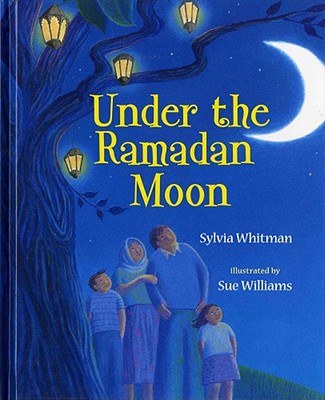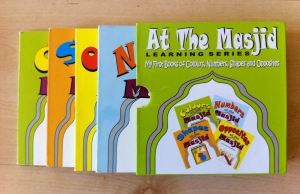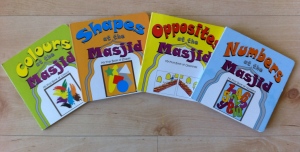It took a while to find this book.
Last year, I checked out every children’s Ramadan book that my local library system had to offer to find *the* early childhood Ramadan book for Noora’s home library. There were more Ramadan books in the secular public library system than I thought! And they covered Ramadan traditions in different places, including Kuwait, Egypt, and America! I think I ended up with a stack of twenty books…I even checked out those non-fiction titles that would be perfect for a child’s research paper on Ramadan, but all I found were runner ups to *the* early childhood Ramadan book for us.
I found Hena Khan’s Night of the Moon: A Muslim Holiday Story (2008), but I found the words to be too much for an early childhood audience…and the illustrations of the mother outside of the house didn’t reflect my views on hijab. I found Na’ima B. Robert’s Ramadan Moon (2009), and while I loved the words…I wasn’t that big a fan of those illustrations either, though I loved seeing how the moon changed from page to page as Ramadan progressed :S.
I wanted something simple, something memorable, and something that rhymed, and while the meter is off to me in certain places…
This is *the* Ramadan book for my girls in their early childhood.
I don’t know how I found it. I guess you could say I was led to it…by the grace of Allah and the process of elimination. I mean, I wasn’t finding anything I was completely enamored with at the library. I think it was actually an Amazon search that brought up this title, and I must’ve liked what I saw because I added it to my wishlist as soon as I saw a few sample pages. I didn’t buy it then though. A couple of months ago, I added it to our baby registry for Safiyya’s aqiqa, and a sweet family member (who isn’t even Muslim!) gifted it to us. Right on time for Ramadan. And ever since the very first night of Ramadan this year, Noora and I read this book before bedtime. Even Safiyya pays attention. I started reading it for the first few nights, and it’s just now the middle of Ramadan and Noora has the words mostly memorized. She is “reading” it to me. This is important–Noora, who just turned 3, had been waiting for Ramadan and knew it was coming as soon as I started to decorate the house. But she didn’t really understand what it meant and why the whole flow of the house changed during this time. Why wasn’t daddy eating with her in the day? Why were so many guests coming at night? Why was mommy cooking as if her life depended on it ;)? Why were both mommy and daddy exhausted? Why weren’t we watching TV? Why did Qur’an and incense fill the house instead? Why weren’t we eating at restaurants (as we often treat Noora to)? Why weren’t we going on as many outdoor excursions (field trips) in the hot summer heat?
I think it’s hard for young children to grasp all that Ramadan means when they can’t fully participate in its activities such as fasting all day, but they can learn from our examples and by discussing simple stories such as Sylvia Whitman’s Under the Ramadan Moon (2011). In this beautiful story, Whitman outlines the basic practices of Ramadan with the repeating refrain “under the moon, under the moon, under the Ramadan moon.” It’s not a story about someone else’s Ramadan, nor is it about the why’s and how’s of Ramadan. It’s about what we do during Ramadan–and I believe that this word choice makes all the difference. By saying what we do during Ramadan, the young reader is instantly included into the narrative of the book and able to recognize the visible actions of Ramadan–most of which he/she has already participated in! <;–Our only exception in this book is that “We [do not] crack nuts and drink hot tea under the moon.” (I’m just not much of a nut-eater, though my DH and DD are 🙂 ).
So this is our new tradition besides the lights, dates, and decorations. A way to visualize and conceptualize Ramadan through a special Ramadan story. And it is now the 15th day of Ramadan–the very middle–a white day when the moon is full, shining in all her glory. A perfect time to show Noora how different the moon looks from the beginning and end of the month when it is crescent-shaped. (By the way, the moon changes with time throughout this book, too! Yippee!) Cuz lately, I’ve been trying to gently expand Noora’s sense of time…minutes, days, and now months, and while she doesn’t quite know what 15 minutes is and exactly what day it is everyday, she does know that it’s Ramadan and it entails certain actions. And though all of Noora’s questions of “why” aren’t specifically answered in this book, she recognizes that Ramadan is a special time of devotion and it is the main reason and answer to her questions. Ramadan is what we do as Muslims. “We wait for the moon./We watch for the moon./We watch for the Ramadan moon.” And when it’s gone, “We live our faith until next year/under the moon,/under the moon,/under the Ramadan moon.”
P.S. In my search, I did find *the* Ramadan books for Noora and Safiyya when they’re upper elementary school age inshAllah–Mary Matthews’ Magid Fasts for Ramadan (1996), Asma Mobin-Uddin’s A Party in Ramadan (2009) and The Best Eid Ever (2007), and Ann P. El Moslimany’s Zaki’s Ramadhan Fast (1994). Great books, get them for your library too! More on them later as the girls grow up, inshAllah…under the moon, under the moon, under the Ramadan moon.









